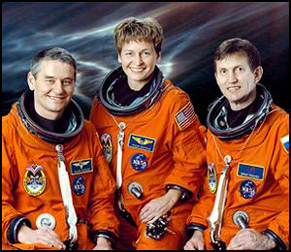This photo shows the ISS Expedition Five crew. From left to right are Mission Commander Valery G. Korzun, Astronaut Peggy A. Whitson and Cosmonaut Sergei Y. Treschev. The crew will have a busy time aboard the station. Already, two spacewalks have been planned into their schedule.
Click on image for full size
Courtesy of NASA
The ISS is a Busy Place These Days!
News story originally written on June 13, 2002
The Expedition Four Crew is going back home to Earth after spending over six months on the International Space Station (ISS). A new team of three, called the Expedition Five Crew, will take over the running of the space station. They arrived at the station a few days ago on the space shuttle Endeavour.
The new Expedition Five Crew will have a busy four-month stay at the ISS. During their stay, the station will be visited by four spacecrafts and the crew plans to do two space walks. Also, they will collect data for 24 different scientific experiments.
The space shuttle Endeavour launched on June 5, 2002. It carried the new crew and almost 3 tons of experiments and supplies, such as food, to the ISS.
Endeavour also carried new parts for the station's robotic arm and two Mission Specialists who can fix and improve the arm. The robotic arm helps build and maintain the station. The arm works the same way that your arm and hand works when you are building things. Hopefully, when the Mission Specialists are through with their three space walks, the arm will be able to move to all parts of the station on a track that works like a railroad track. Being able to move along the track will allow the arm to reach easily all parts of the station.
Endeavour will return the Expedition Four Crew to Earth later this week, landing at Kennedy Space Center in Florida.
You might also be interested in:

It was another exciting and frustrating year for the space science program. It seemed that every step forward led to one backwards. Either way, NASA led the way to a great century of discovery. Unfortunately,
...more
The Space Shuttle Discovery lifted off from Kennedy Space Center on October 29th at 2:19 p.m. EST. The weather was great as Discovery took 8 1/2 minutes to reach orbit. This was the United States' 123rd
...more
A moon was discovered orbiting the asteroid, Eugenia. This is only the second time in history that a satellite has been seen circling an asteroid. A special mirror allowed scientists to find the moon
...more
Will Russia ever put the service module for the International Space Station in space? NASA officials want an answer from the Russian government. The necessary service module is currently waiting to be
...more
A coronal mass ejection (CME) happened on the Sun early last month. The material that was thrown out from this explosion passed the ACE spacecraft. The SWICS instrument on ACE has produced a new and very
...more
J.S. Maini of the Canadian Forest Service called forests the "heart and lungs of the world." This is because forests filter air and water pollution, absorb carbon dioxide, release oxygen, and maintain
...more
In late April through mid-May 2002, all five naked-eye planets are visible at the same time in the night sky! This is includes Mercury which is generally very hard to see. You won't want to miss this!
...more















